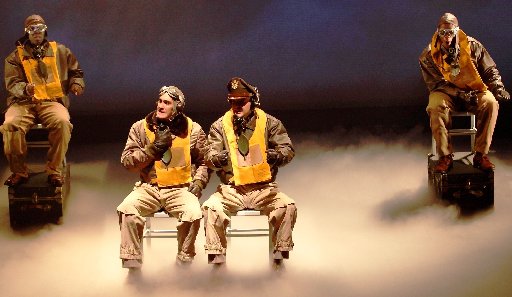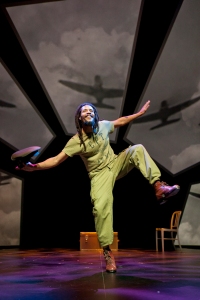Excerpted by kind permission from Neals Paper

The characters are sitting in simple faux metal chairs, the kind you can find at any Target or Staples, but they are miming tricky arm and hand maneuvers associated with controlling an airplane, swaying and tensing as if fighting air currents and gravity, barking commands, issuing assurances of their support, saying prayers, and mouthing curses, all while engaged in the battle of, and a battle for, their lives.
The scene I’m describing is fraught with apprehension and suspense. The men depicted are American pilots in the closing days of World War II. The confrontation we see is for the domination of the German capital, Berlin. We have seen the men train, we have seen them overcome obstacles in their course of becoming fighter pilots, and we have come to care about them deeply, so much that we are as invested in their personal safety and survival as we are with the critical mission they are fulfilling. History of several kinds is unfolding, but history takes second place to the men and their fates as we, the audience for Trey Ellis and Ricardo Khan’s FLY at New Brunswick’s Crossroads Theatre, palpably experience and feel the danger that can threatens to overcome both our heroes and Western civilization.
Ricardo Khan, as director, has built his production to a fever pitch. Lighting by Rui Rita and Jake DeGroot accentuates the mood and atmosphere in the Crossroads auditorium. Yellow-orange lights are seen at all angles simulating active gunfire. Meanwhile, the general scene begins to look dark and smoky. Everything on stage is in plain view, but it seems engulfed, to great and moving effect, in the murky fog and clashing color of war.
The pilots we come to see, know, admire, and love the most are members of the famous Tuskegee Airmen, a squadron of black aviators that fought with acknowledged distinction as World War II came to close. Their skin color made a difference within general American society and the military hierarchy of their time. The Tuskegee Airmen as a group were in the position Jackie Robinson faced as an individual playing baseball. They were selected by powers who wanted rational change to break a racial line that placed artificiality and prejudice above reality and common sense. As FLY proceeds, their race disappears as our concern for them and appreciation for their accomplishments take precedence.
Eliis and Khan are shrewd about how they tell their story. They do not deal with all of the members of the all-black 332nd Fighter Group and 477th Bombardment Group of the 1944-45 Army Air Corps. Taking a cue from Hollywood’s bomber-crew movies, they depict four characters who represent different walks of life, have different attitudes about fighting, and express different motivations for wanting to be part of what was known as the Tuskegee Experiment, the integration of black troops into previously exclusive military assignments, an initiative many deemed as foolhardy and wanted to see fail.
By centering on different types, Ellis and Khan already explode the idea there’s one black man who can be exchanged wholesale for any other. They also allow us to key in on the personalities characterized.
Khan, as director, especially works to make FLY more than another tribute to the Tuskegee troops and a service play with the expected elements. For one thing, he begins his production and punctuates sequences, and intervals between scenes with a tap dancer, Omar Edwards, who expresses anger, angst, humor, caution, tension, fear, and camaraderie with great vigor and poignancy.
From Edwards’s dancing to the climactic bombing of Berlin, FLY coalesces into a cogent, involving piece. The leisurely time Khan takes in getting you to know the characters as individuals and the intolerance they must sometimes deal with, builds into edgy, febrile anxiety giving FLY one of the most exciting, involving denouements a play can have.
The battles are staged and lit to turn us into nervous, perspiring worry-warts. Watching men we have a stake in face death and act as a team push us to where we won’t be able to stand it if anything goes wrong with “our men” or impending doom doesn’t reverse itself at least to hope for a favorable outcome..
In the end, the triumph of FLY is race doesn’t matter. Characters become their names and identities rather than just one of the Tuskegee guys. Our care of them is tied to how they are and what they mean to us and not because of where they trained or their historic role in military and social history.
Khan’s ensemble cast is uniformly excellent. Brooks Brantly, as the Chicagoan who likes jazz, whiskey, gambling, and women, is humorous in portraying his urban appetites while showing that beneath his character’s swagger, there is someone who wants to excel as a pilot and eliminate some Nazis.
Desmond Newson brings out the youthfulness and ambition of his character, a New Yorker who enlists underage because he is enamored of flying and also wants to be part of a war to rid the world of Hitler’s oppression.
Damian Thompson has a different kind of naivety and inspiration from Newson’s New Yorker. He is an islander striving for excellence and wanting acceptance, from Americans and particularly black Americans, for being a citizen of the U.S. and a stakeholder in its future. Thompson’s character is the sincere, studious one who at times gets as caught up in what he doesn’t understand as much as excelling in what he comprehends easily.
Terrell Wheeler has a natural calm that combines seriousness with dignity as the college-educated Iowan who retains his home roots and is contrasted to the guys from Chicago and New York.
Anthony J. Goes is effective as the training captain, especially as he gets increasingly upset during the training sequence.
Ross Cowan exudes reality as the young co-pilot who becomes comfortable with his black escorts, even to the point of mentioning a lynching in his town.
Brandon Nagle is strong as the pilot who may show surprise on his face but takes working alongside black colleagues quickly in his stride.
Beowulf Boritt’s serviceable set is most notable for his propeller-shaped background that places screens in each petal of the propeller so Khan can make good use of Clint Allen’s texturing projections. Rui Rita, Jake DeGroot, and John Gromada produced lights and sound that heightened the already feverish suspense in the war passages. Read the full review >>
[Crossroads Theatre, 7 Livingston Avenue, New Brunswick, NJ] April 7-17, 2016; crossroadstheatrecompany.org.

